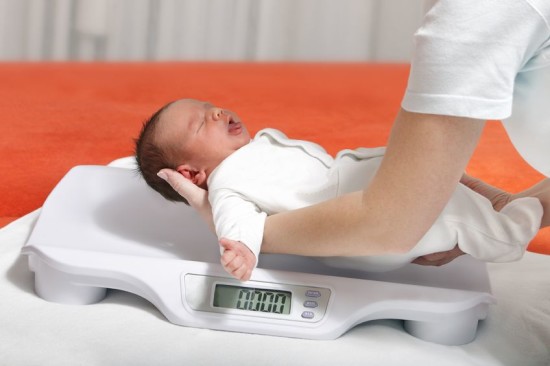
Is your baby not putting on weight? – Copyright: benedamiroslav / 123RF Stock Photo
THERE are several reasons why babies fail to thrive and don’t seem to be putting on weight.
None of the reasons is breast milk.
At the recent PRISMA 2015 conference, organised by the Malaysian Breastfeeding Peer Counsellor Association, participants were glued to their seats listening to the topic “Poor Weight Gain and Failure to Thrive Babies – Should Breastfeeding Continue?” by Dr Hairin Anisa Tajuddin, paediatrician and lactation consultant at Monash University Malaysia.
Dr Hairin Anisa has had to deal with her fair share of babies who failed to thrive. She is a staunch breastfeeding advocate and she made it clear that breast milk is the gold standard.
Blocked ducts
She related the case of a baby who was brought in to see her at one month old. The baby’s weight had not increased at all in the one month since birth. The baby had frequent vomiting. The baby would suckle and then throw up each time. And the mother said her breast milk was very watery.
Dr Hairin Anisa found that the baby had milk reflux. In addition, the mother had a lot of lumps and blocked ducts. The mother was not expressing the milk and was just direct breastfeeding her child. This caused curds and multiple blocked ducts.
The baby was not putting on weight because milk transfer was a problem. The baby was not getting much milk because of the plugged ducts and because the baby was vomiting a lot. In addition, the quality of milk had less fat because it was watery.
In such cases, mothers are often wrongly advised to stop breastfeeding or to top up with formula milk to to add a milk fortifier.
Dr Hairin Anisa said that some doctors might even prescribe an anti-reflux milk.
“This is something I disagree with because my way of management is to uphold breastfeeding as the gold standard.
“So my advice to that mother was to breastfeed her baby in the upright position. If the baby looks like he or she is starting to gag, unlatch the baby, help the baby to burp and then relatch. Keep doing that until the baby is full and then put baby in a position where the stomach is at a lower level than the head, maybe at a 30 degree angle,” said Dr Hairin Anisa.
She also recommended the mother massage the baby’s stomach two to three times a day to help improve the baby’s digestion.
For the plugged ducts, she recommended that the mother apply frequent hot compresses to the breast and to keep massaging the breast so that the hindmilk, which is thick and fatty, will be removed and the baby will get it when he suckles.
“I also advised the mother to take lecithin which prevents blocked ducts and Vitamin C to heal the blocked ducts.
“I also told her that if you want to have more fat in the breast milk, you must frequently pump, otherwise the fatty milk will not be removed from the breasts. And, if not removed, it will turn to curds and the only milk that the baby gets is the watery milk,” said Dr Hairin Anisa.
Her method worked and the baby then started putting on weight.
Tongue tie
In another case, the baby came to her at 2.5 months. The baby’s birth weight was 2.8kg. The baby was exclusively breastfed until Day 10. The baby’s weight did not go up much, so the mother gave her formula milk up till Day 24, when the weight still did not go up much and the mother gave up on formula milk and returned to exclusively breastfeeding, but the weight went down, instead. So, she topped up with formula milk and the weight went up a bit.
“When she came to see me, I saw that there was a latching problem and the baby was crying because she couldn’t sustain the breastfeeding. I also noticed that the baby had tongue tie, so I immediately did a frenotomy, because they had come all the way to Kuala Lumpur from Negri Sembilan.
“The mother’s milk production was low and the latching was problematic and the hindmilk was very thin (watery). She had multiple lumps in her breasts.
“So, I taught her how the baby should latch, how to breastfeed and each time the baby is on the breast, to compress and massage the breasts,” said Dr Hairin Anisa.
This baby’s weight increased after that.
Distractions
In another case, the baby came in at 6.5 months old. She was about 6.2kg or 6.3kg. The mother said her baby didn’t want to feed. The baby was easily distracted and not able to concentrate on feeding, except at night. This caused an insufficient intake of milk.
“I advised the mother to avoid all distractions. Even in the daytime, feed in a dark room with no distractions at all, no sounds, no talking. Because of her age, I also asked the mother to start on the complementary feeding,” said Dr Hairin Anisa.
This baby’s weight also increased after that.

Dr Hairin Anisa Tajuddin: ‘Don’t think that the breast milk offers sufficient calorie intake after the child is six months old.’
Reasons for failure to thrive
According to Dr Hairin Anisa, some of the medical causes for failure to thrive are:
- Gastro-oesophageal reflux with frequent vomiting
- Tongue tie and other abnormal intra-oral structures
- Endocrine disease (congenital hypothyroid)
- Any syndrome (Down, Pierre Robin, Turner)
- Chronic illness (heart failure, liver disease – biliary atresia, malabsorption causes, hyperactive airway disease)
- Rare causes – inborn error of metabolism, usually is contraindicated to breastfeeding, and immunodeficiency disorders which cause the baby to get frequent infections and the frequent infections lead to failure to thrive.
The nutritional causes are:
- Breastfeeding problems – interruption of breastfeeding kinetics leads to inadequate milk production, milk transfer, quantity and quality of milk intake.
- Complementary diet inadequacy – After six months of age, when baby is not taking an adequate amount of calorie per day from his meals although he is still being breastfed.
Dr Hairin Anisa said that often the breast milk is still blamed in such cases, when it is not at fault.
The reasons for breastfeeding problems are:
- Incorrect breastfeeding techniques – positioning (mother who is not confident and/or stressed out), latching (tongue tie, nipple confusion), short and infrequent feeds (which result in more foremilk rather than hindmilk, and reduced milk production)
- Breast problems – recurrent plugged ducts, post-operative breast abscess
The reasons for complementary diet inadequacy:
- Low calorie meal (just fed with puree)
- Less frequent meals than recommendation
- Inadequate amount per feeding (small portions)
- Too dependent on breastfeeding – some breastfeed the baby just before a meal. When the baby is full, he or she will not eat much, so mothers are advised not to breastfeed before baby’s meal.
- Too much fruits / snacks instead of meals – some parents think giving a banana is sufficient for a meal, but it is not. A baby’s meal should have carbohydrates and protein as well.
How much feeding?
According to Dr Hairin Anisa, once the child reaches six months, complementary feeding should be introduced. This means that while the mothers continue breastfeeding, the infant is also given meals suitable for their age.
The recommended frequency of meals is:
6-8 months
615Kcal a day
2-3 times feeding frequency a day
1-2 snacks a day
9-11 months
686 Kcal a day
3-4 times feeding frequency a day
1-2 times snacks a day
12-14 months
945Kcal a day
4-5 feedings a day
1-2 snacks a day
She said a common mistake is that mothers make the complementary diet very tasteless because they don’t want to add sugar and salt to the infant’s diet. Parents need to make the food tasty and they can do it using natural flavours instead of adding salt and sugar.
“Don’t think that the breast milk offers sufficient calorie intake after the child is six months old. The baby after six months has increased activity and increased metabolism, so the child needs extra energy, which cannot be provided just by breast milk only.
“But that doesn’t mean that you should blame the breast milk!” she cautioned.
For the infant to thrive after six months, Dr Hairin Anisa recommends:
- Exclusive breastfeeding continues to be practised.
- Complete and adequate calorie in complementary diet as recommended.
- Treat underlying health problem in baby or mother.
© 2015 Thots N Tots. IMPORTANT: This article was faithfully reproduced from Thots N Tots website, with the permission of the owner. To view the original article on Thots N Tots’s website, please visit http://thotsntots.com/why-is-my-baby-not-putting-on-weight/ .

Submit a comment
Your email address will not be published. Required fields are marked *
There are 0 comments